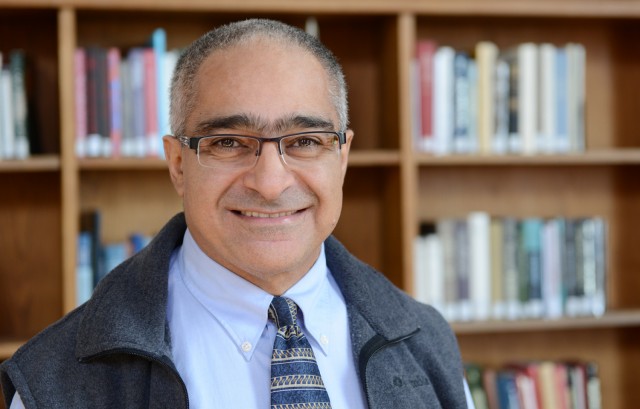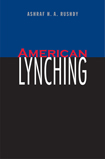5 Questions With . . . Ashraf Rushdy on Lynching in America

(Story contributed by Jim H. Smith)
In this issue of The Wesleyan Connection, we ask “5 Questions” of Ashraf Rushdy, professor of English, professor of African American Studies and chair of the African American Studies Program. Rushdy is the author of American Lynching, a meticulously researched interpretive history of how lynching became a uniquely American phenomenon and how it has endured, evolved and changed over the course of three centuries. The book was published by Yale University Press in October 2012.

Q: Scholars have been writing about lynching for more than a century now. There is a significant body of extant literature. What did you aim to achieve with American Lynching? How is it different from other books on the subject?
A: There are, indeed, many books about lynching, and I’m beholden to that body of scholarship. Many of the books that have been written are about specific cases of lynching. There are fewer books that attempt to interpret the phenomenon generally. That’s what I have attempted to do with my book.
Lynching has been part of the American fabric for a long time, but the term has not consistently described the same thing over that time. I wanted to understand how lynching had taken root in America and how one practice, widely referred to as lynching, could develop into something quite different. And I wanted to offer a strong interpretation.
It’s interesting to note that lynching was not always a racially motivated act. The relative absence of lynchings in slaveholding Northern states and the occurrence of lynching in non-slaveholding western states is explained by the extent to which the mores and established precedents that emerged from those original slave laws took hold of the imagination of the residents of those states.
Q: Is lynching a uniquely American phenomenon, or is there a uniquely American “style” of lynching?
A: Well, the term “lynching” is certainly uniquely American. It derives from Colonel Charles Lynch, the leader of the Bedford County, Virginia militia during the American Revolution. When his soldiers captured three Tories in the summer of 1780, they whipped two and hanged the third, all without a trial or military tribunal. Lynch continued to pursue this form of summary justice for some time.
However, the behaviors described as lynching – the persecution and torture of people who are inevitably described by the persecutors as “others” – predates the creation of the United States. What especially defines lynching as an American phenomenon was the fact that it ultimately came to focus primarily on African Americans.
It’s also important to note that lynching has generally been, throughout its history, a social phenomenon. For a time – from the late 19th Century until the 1930s – lynching became a form of spectacle. Thousands of people would gather to observe, and sometimes actively participate in, the lynching. The torture inflicted upon those who were lynched was often barbaric in the extreme.
Q: In the book you note that there was a distinctive “Age of Lynching” that extended from roughly the Reconstruction period until the mid-20th Century. What factors were at play in eventually bringing this ugly phenomenon to an end?
A: Even as the “spectacle lynchings” that I described earlier were occurring during the 1920s, there was growing opposition to lynching. As social mores changed, it became increasingly important not only to end lynching in America, but to be able to declare that lynching had ended.
By the 1960s there were still occasional years with multiple lynchings, but these became fewer and fewer and farther apart.
We still have hate crimes in this country. But widespread social acceptance of lynching began to wane even as lynching was still commonplace.
Q: What inspired you to write American Lynching?
A: In 1998 I was awarded a fellowship to the National Humanities Center in Research Triangle in North Carolina. At the time I was doing research for a book I planned to write about a housing desegregation case in Texas. The town of Vidor, near the Louisiana border, had been all white since the 1920s, but a federal judge ordered the desegregation of public housing in more than 30 Texas counties, including the one where Vidor is located.
The first black people who moved into public housing in Vidor were terribly persecuted. The Ku Klux Klan, which had a strong presence in Vidor, held rallies. One of the black men who moved into public housing, William “Bill” Simpson, was eventually hounded out of Vidor. He moved to Beaumont, nearby, and on his second night in town was killed in what was apparently a random act of violence.
Right after I arrived in North Carolina, however, another incident occurred. An African American man named James Byrd Jr. was murdered by three white men in Jasper, Texas, which is only about 60 miles from Vidor. It was a particularly gruesome case. The three killers, at least two of whom were white supremacists, picked Byrd at random. They dragged him by a pickup truck for several miles until his body hit a culvert and he was killed. Then they left his decapitated body in front of an African American cemetery.
There was significant debate in national media about whether the Byrd murder was an act of lynching. African American media were uniformly describing it as a lynching. But other news media said it was not. Interestingly, the Klan rallied against Byrd’s killers. I became very interested in the case, and especially in understanding what really constitutes lynching. The idea of lynching has held a powerful value in America for three centuries, but its meaning has evolved significantly during that time. Byrd’s killers were eventually convicted.
Q: What did your research teach you about this peculiarly cruel activity and the American identity?
A: I was really interested in possible origins and certain continuity. Lynching, in many ways, replaced slavery as a form of exploiting and destroying black lives, and so I wanted to see how the practice evolved from those original slave laws that codified who was and who was not free, who could and who could not be punished with impunity. As well, I wanted to see in what ways lynching simultaneously expressed some of the nation’s most valued political principles, such as popular sovereignty, and what those contradictions between different ideals might mean.

